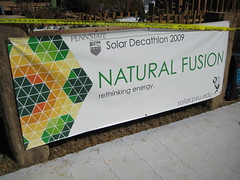| |
- GM agrees to sell Hummer to Tengzhong, but will Chinese regulators kill the deal? Meanwhile, Saturn dies.
- Natural Fusion at Work in the Solar Decathalon
- PG&E CEO: We left Chamber Of Commerce because they lied to us about climate policy; Chu says "it's wonderful" companies are fleeing the Chamber
- Energy and Global Warming News for October 9: Granhom brings 160,000 clean energy jobs to hard-hit Michigan
| Posted: 10 Oct 2009 07:55 AM PDT
Seriously, $150 million? As I wrote back in June:
But WashPost buried the lede:
The Hummer sale story isn't really news — but if Chinese regulators actually stopped the acquisition, that would be quite a story, though perhaps not an utter shocker (see "China begins transition to a clean-energy economy"). I wrote back in June:
This sale is unjustifiable at $150 million. Let's hope the Chinese government is smarter than ours. Related Posts: |
| Natural Fusion at Work in the Solar Decathalon Posted: 10 Oct 2009 05:28 AM PDT Part 1 was an intro to the Solar Decathalon, a contest for innovative, high-tech, high-efficiency, solar-powered homes, which is open to the public in DC from October 9-13 and 15-18. In this reposting, guest blogger A. Siegel focuses on one finalist. For in-depth discussion of all the others, go to his website Get Energy Smart! NOW!!! No, we're not speaking about Cold Fusion, but Penn State's entry into the DOE Solar Decathlon, which opens Friday on the Mall in Washington, DC. Let's take a look at some of Natural Fusion's features from its website, which is dynamic, enabling rapid connection of concepts and approaches with the home's physical layout.
The landscaping has these separate components:
It is an impressive line-up in what might be thought of as very limited space, not even counting the herb garden on the wall in the kitchen, but let's call attention to two:
Sadly, it will be difficult to get the full feeling of calm provided by the planting amid thousands visiting the house, but Natural Fusion's landscaping seems to be a top notch contender based on web descriptions. (By the way, re web, this is a good example of the difficulties of the site's design: moving the mouse just a little leads to lost / changed descriptions and, while it might exist, a combined (full) listing of all the landscapting wasn't apparent to this reader.) Some Energy COOL Technologies / Approaches Every one of the Solar Decathlon entrants incorporates some mix Energy COOL technologies and approaches. Let's take a look at a few of Penn State's.
Now, what will this one-of-a-kind (first of a kind?) Natural Fusion home going to cost you? Well, the budget without a penny for labor (or inspections or …) was $190,460 for a small living space … But, hold it, that isn't the estimated price for production models. This provides a "build your own" option. Going top-of-the-line, across the board, turned the base-line $41,000, 675 square foot house, into a $166,750 leading edge renewable energy home. Hmmm … If interested, Natural Fusion is running a live monitoring system. At the time that I looked, 4:09 pm, Tuesday, 6 Oct, it was generating .1 kw … |
| Posted: 09 Oct 2009 01:15 PM PDT
You just can't keep up with all the news about the nano-Chamber of Commerce. But here are the key points:
|
| Posted: 09 Oct 2009 11:36 AM PDT
In Michigan, A Yellow Light For Green Jobs
Religious Groups Lobby for Climate Bill
Web Site Tracks Europe's Clean Energy Growth
Kingsnorth: A Blow Against Coal, or A Move For Clean Coal?
UN talks to end without deal on crucial issues
States not meeting renewable energy goals
<a href="http://ad.doubleclick.net/click%3Bh=v8/38c1/3/0/%2a/d%3B216761739%3B0-0%3B0%3B4426061%3B4307-300/250%3B32790460/32808337/1%3Bu%3Do_2a_5bCS_5dv1_7c498EE27600004A3D_2dA2B0B850000005B_5bCE_5d%3B%7Eokv%3D%3BA%3D1%3BD%3D3%3BC%3D1%3BC%3D12%3BE%3DCAAAI%3BG%3D2%3BS%3D12%3BS%3D245%3BB%3D1%3BB%3D28%3B%7Eaopt%3D2/1/ff/1%3B%7Esscs%3D%3fhttp://clk.atdmt.com/UMS/go/161915955/direct/01/" target="_blank"><img src="http://view.atdmt.com/UMS/view/161915955/direct/01/3017804″/></a><noscript><a href="http://ad.doubleclick.net/click%3Bh=v8/38c1/3/0/%2a/d%3B216761739%3B0-0%3B0%3B4426061%3B4307-300/250%3B32790460/32808337/1%3Bu%3Do_2a_5bCS_5dv1_7c498EE27600004A3D_2dA2B0B850000005B_5bCE_5d%3B%7Eokv%3D%3BA%3D1%3BD%3D3%3BC%3D1%3BC%3D12%3BE%3DCAAAI%3BG%3D2%3BS%3D12%3BS%3D245%3BB%3D1%3BB%3D28%3B%7Eaopt%3D2/1/ff/1%3B%7Esscs%3D%3fhttp://clk.atdmt.com/UMS/go/161915955/direct/01/" target="_blank"><img border="0″ src="http://view.atdmt.com/UMS/view/161915955/direct/01/3017804″ /></a></noscript> "We have great bones as a state," she says. "We know how to build stuff. We will build on that strength and diversify this economy. We will lead the nation in creating jobs in renewable energy. We're not going to be viewed as Luddites." |
| You are subscribed to email updates from Climate Progress To stop receiving these emails, you may unsubscribe now. | Email delivery powered by Google |
| Google Inc., 20 West Kinzie, Chicago IL USA 60610 | |


 When we last left GM, they were pursuing buyers for Hummer and Saturn (see "
When we last left GM, they were pursuing buyers for Hummer and Saturn (see " Landscaping
Landscaping The WashPost of course didn't use my headline, since for them, every silver lining has a cloud. Obviously Michigan has had massive job losses in the auto industry, but how exactly does that translate into a "yellow light" for green jobs, except as a too-cute play on words at the expense of the real story: Granholm has done her best to embrace the fastest growing source of new jobs in the nation and the world — clean energy jobs. It's hard to hold her responsible for the incompetence and shortsightedness of the US auto industry, whose collapse has been decades in the making, but she clearly deserves a lot of the credit for making Michigan hospitable to clean energy industries.
The WashPost of course didn't use my headline, since for them, every silver lining has a cloud. Obviously Michigan has had massive job losses in the auto industry, but how exactly does that translate into a "yellow light" for green jobs, except as a too-cute play on words at the expense of the real story: Granholm has done her best to embrace the fastest growing source of new jobs in the nation and the world — clean energy jobs. It's hard to hold her responsible for the incompetence and shortsightedness of the US auto industry, whose collapse has been decades in the making, but she clearly deserves a lot of the credit for making Michigan hospitable to clean energy industries.


